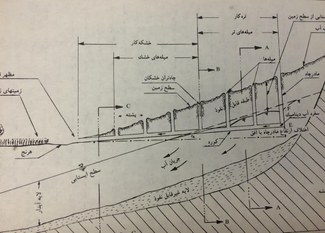New Persian-language Materials at the ISAW Library
The mitigation of water scarcity in ancient Persia is often attributed to the successful utilization of underground aqueducts known as qanāt or kāriz, which transfer water at an incline from natural water sources at higher altitude to settled areas at lower altitude.
Pictured here is a cross-section of a qānāt from page 12 of one of the works being cataloged: قنات سازى و قنات دارى/ Qanat Construction and Maintenance, by بهنىا الکرىم عبد(ʻAbd al-Karīm Bihniyā). Markaz-i Nashr-i Dānishgāhī,1988.

Many of the works in this collection of material deal with the historical development and dissemination of this technology and its impact on the growth of civilization in ancient Persia, along with the continued legacy of this system in modern Iran. The qanāt system is still in use today and exists alongside more modern hydraulic technologies. The items in this collection are not widely held in the West and represent a significant addition to ISAW’s growing holdings on ancient hydrology.
The following works are representative of this part of the collection:
- نظام آبيارى سنتى در نائين (=“Traditional Irrigation Systems in Nāʼīn”; 2005; SMALL TC908.N35 N59 2005). A survey of the historical development of the qānāt system and other irrigation techniques in the city of Nāʼīn in central Iran, where many ancient qānāts are still in use even today. This work, commissioned by the Iranian National Committee on Irrigation and Drainage, provides an intriguing perspective into how water usage remains an important link between Iran’s past and present.
- قنات سازى و قنات دارى (=“Qanat Construction and Maintenance”; 1988; SMALL TD404.7 .B44 1988) by بهنىا عبد الکرىم(ʻAbd al-Karīm Bihniyā). This work provides a more technical description of how qānāts have been used to deliver water to settlements and towns in Iran for thousands of years. Included in the work is an overview of famous ancient qānāts in each Iranian province.
Also in this lot are several examples of classical Persian travel literature, or safarnāmah, which provide historical and geographic description of Iran and surrounding regions. (For an introduction to the genre, see Muzaffar Alam and Sanjay Subrahmanyam, Indo-Persian Travels in the Age of Discoveries. Cambridge: Cambridge University Press, 2007). The safarnāmahs being added to the ISAW collection deal primarily with individual Iranian provinces or cities.
Some highlights include:
- فارسنامه (“Fārsnāmah”; 2006; SMALL DS324.F3 I3 2006) by ابن البلخى (Ibn Balkhi). The Fārsnāmah is a safarnāmah written in the 12th century by an anonymous author known conventionally as Ibn Balkhi, who describes the province of Fārs in the southwest of Iran, the epicenter of the Achaemenid Empire. The work is notable for its history of the pre-Islamic rulers of Persia and the Arab conquest of the province in 643 C.E. The latter part of the work provides a geographical account of Fārs with a description of antiquities and historic fortresses.
- آثار عجم (“Ās̲ār-i ʻAjam”; 1998; DS324.F3 F873 1998) by محمد نصير فرصت شيرازى (Muḥammad Nāṣir Furṣat Shīrāzī, pen name Furṣat al-Dawlah). A safarnāmah of Fārs, originally published in 1896 some 500 years after Ibn Balkhi’s Fārsnāmah and printed in India (where many Persian books were published at that time). A copy of this important work was published in both Tehran and Bombay in 1935. The 1998 version ISAW now has was published in Tehran and was most likely based on the 1935 version. The work is notable for containing over fifty detailed illustrations of various ancient historical sites of Persia (see image above).
Yasha Razizadeh (yvr2@nyu.edu) is Cataloger for Persian Language Materials at New York University and is currently completing both his MA in History at NYU and his MLIS at Long Island University.